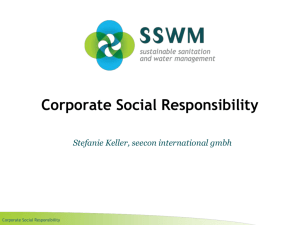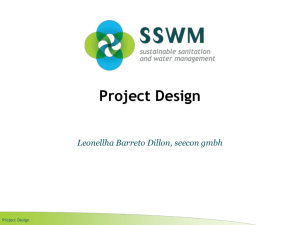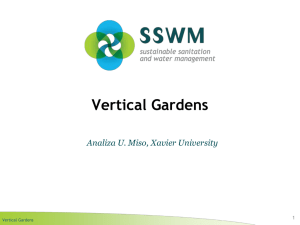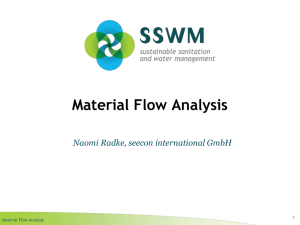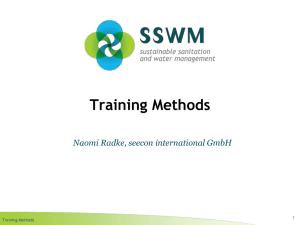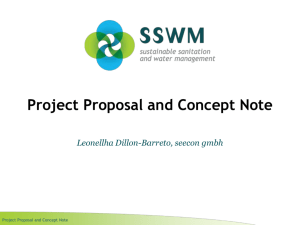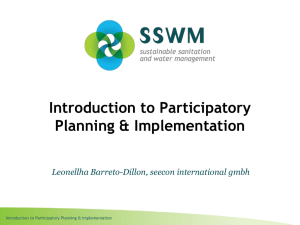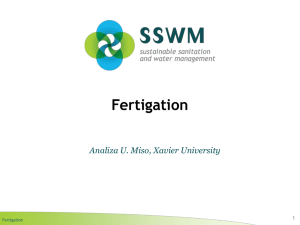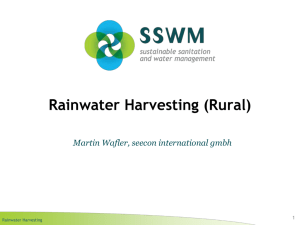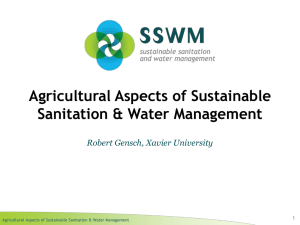SSWM Implementation Tools Michael Kropac, seecon international gmbh 1
advertisement
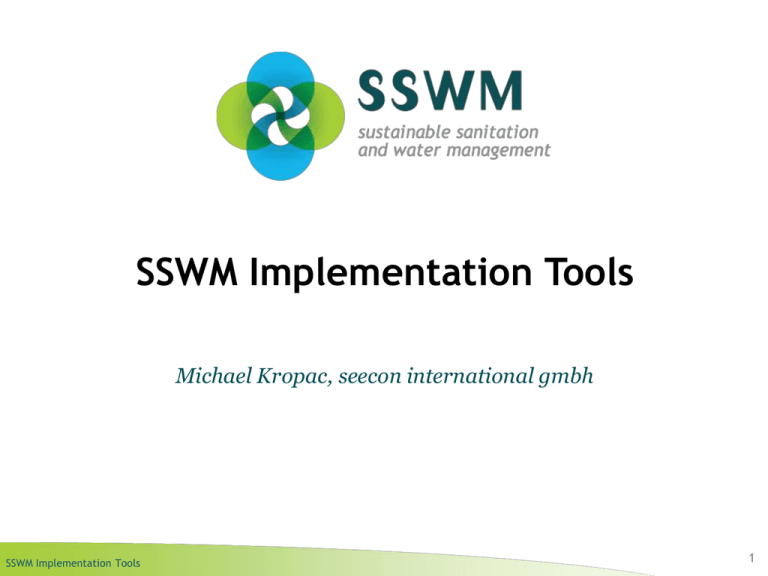
SSWM Implementation Tools Michael Kropac, seecon international gmbh SSWM Implementation Tools 1 Find this presentation and more on: www.sswm.info. Copyright & Disclaimer Copy it, adapt it, use it – but acknowledge the source! Copyright Included in the SSWM Toolbox are materials from various organisations and sources. Those materials are open source. Following the opensource concept for capacity building and non-profit use, copying and adapting is allowed provided proper acknowledgement of the source is made (see below). The publication of these materials in the SSWM Toolbox does not alter any existing copyrights. Material published in the SSWM Toolbox for the first time follows the same open-source concept, with all rights remaining with the original authors or producing organisations. To view an official copy of the the Creative Commons Attribution Works 3.0 Unported License we build upon, visit http://creativecommons.org/licenses/by/3.0. This agreement officially states that: You are free to: • Share - to copy, distribute and transmit this document • Remix - to adapt this document. We would appreciate receiving a copy of any changes that you have made to improve this document. Under the following conditions: • Attribution: You must always give the original authors or publishing agencies credit for the document or picture you are using. Disclaimer The contents of the SSWM Toolbox reflect the opinions of the respective authors and not necessarily the official opinion of the funding or supporting partner organisations. Depending on the initial situations and respective local circumstances, there is no guarantee that single measures described in the toolbox will make the local water and sanitation system more sustainable. The main aim of the SSWM Toolbox is to be a reference tool to provide ideas for improving the local water and sanitation situation in a sustainable manner. Results depend largely on the respective situation and the implementation and combination of the measures described. An in-depth analysis of respective advantages and disadvantages and the suitability of the measure is necessary in every single case. We do not assume any responsibility for and make no warranty with respect to the results that may be obtained from the use of the information provided. SSWM Implementation Tools Find this presentation and more on: www.sswm.info. Contents 1. Implementation Tools 2. Hardware 3. Software A) Awareness Raising Tools B) Command & Control Tools C) Economic Tools D) Creating an Enabling Environment 4. References SSWM Implementation Tools Find this presentation and more on: www.sswm.info. 1. Implementation Tools SSWM Implementation Tools give a concrete and specific answer to the main question: How can I optimize my local water management and sanitation system and make it more sustainable? = „What can I do?“ SSWM Implementation Tools 4 Find this presentation and more on: www.sswm.info. 1. Implementation Tools… ...can be technical (Hardware) as well as economic, political and social tools (Software). Seven overarching themes include a large number of different tools to: • Water Sources Management • Water Purification • Water Distribution • Water and Nutrient Use • Wastewater Collection • Wastewater Treatment • Reuse and Recharge of Nutrients and Water Source: www.sswm.info SSWM Implementation Tools 5 Find this presentation and more on: www.sswm.info. 2. Hardware Hardwares are… … technical tools to optimize your water and nutrient cycle … they answer questions like: ?What technology options exist? Save Water ! ?How can I design and built them? Save Energy ! ?In which context are they applicable? Save Money ! ?Can I built them on my own? Save Nutrients! ?How much do they cost? Source: www.sswm.info ?How do I maintain and operate them? ?Etc, etc, etc, etc, etc, etc… SSWM Implementation Tools 6 Find this presentation and more on: www.sswm.info. 2. Hardware Hardwares are… … technical tools to optimize your water and nutrient cycle Source: www.sswm.info SSWM Implementation Tools • These are physical solutions that you can see and touch with your hands such as water filters, toilets, treatment systems or technologies to recycle water and nutrients. • Usually, you will nee a combination of different hardware and software tools to really make a sustainable impact. 7 Find this presentation and more on: www.sswm.info. 3. Software Why software tools?... Source: http://www.wsp.org/userfiles/image/2009_JUL.jpg [Accessed: 23.03.2010] … because hardware is not enough! SSWM Implementation Tools 8 Find this presentation and more on: www.sswm.info. 3. Software Softwares are… … are instruments and set-ups with aim to change the behaviour and attitudes of different actors • Software tools are a bit "fuzzy", as one cannot really see or touch them. • Software tools can also be implemented without combining them with hardware tools. • Software tools are divided into four different groups Source: www.sswm.info SSWM Implementation Tools 9 Find this presentation and more on: www.sswm.info. 3. Software What are Software Tools? The SSWM Software Tools are divided into four groups: SSWM Implementation Tools 10 Find this presentation and more on: www.sswm.info. A) Awareness Raising Tools ... because people pursue goals in accordance with their values and knowledge. Different types of information, education and communication instruments used to initiate behavioural change and to stimulate social pressure towards a more sustainable use of water resources. Tools: •Media campaigns •Advocacy to influence leaders •Empower young people as promoters •School campaigns Etc. Source: http://portal.worldwaterforum5.org/wwf5/enus/Lists/Kyoto%20Prize%20Application%20Form/Attachme nts/68/Tankaposter-%20poster%20guj.jpg [Accessed: 23.03.2010] SSWM Implementation Tools 11 Find this presentation and more on: www.sswm.info. A) Awareness Raising Tools Example: Advocacy Advocacy is the action of delivering an argument to gain commitment from political and social leaders and to prepare a society for a particular issue. Influencing and involving important leaders, because political support together with support from community leaders and religious leaders can give a water-related project or campaign a powerful boost. Political support: The mayor of Mymensingh Pourashava has supported the Malgudam community to create a demonstration plot for using toilet bags as fertilizer. Source: http://www.pseau.org/gif/couv_gtz_ecosan_newsletter.gif SSWM Implementation Tools 12 Find this presentation and more on: www.sswm.info. B) Command & Control Tools … because people want to avoid the penalties for non-compliance. Direct regulations which government bodies can establish so water users as well as services providers are obliged to comply. Tools: • Prohibitions • Restrictions • Permits • Standards • Etc. SSWM Implementation Tools Source: http://themoderatevoice.com/wordpressengine/files/2008_july/Stop_Sign.jpg [Accessed: 23.03.2010] 13 Find this presentation and more on: www.sswm.info. B) Command & Control Tools Example: Water Restrictions in Water Use Restrictions, rationing or full prohibitions are legal tools that have a direct impact on the forms of conduct. In water use restrictions, public authorities or independent regulatory agencies establish restrictions and bans that water users and provides are obliged to follow. Water Policeman in Australia controlling that water is properly used. Source: http://www.ballardian.com/images/water_police.jpg SSWM Implementation Tools 14 Find this presentation and more on: www.sswm.info. B) Command & Control Tools Example: Australia drought Stages Planning Stage Reticulation sprinklers: 1 2 3 4 5 Daily Alter nate days 3 times/ week Twice weekly Once weekly Sprinkler times: Before 9.00am or after 6.00pm Hose watering of gardens: Any time Swimming pools: Car washing: No restriction No overfilling No restriction 6 7 No sprinklers No hose watering No topping-up No filling Bucket only Different concrete stages of water restrictions which can currently be applied in Western Australia Source: http://www.austlii.edu.au/au/legis/wa/consol_reg/waub2007297/sch2.html Accessed: 08.06.2010] SSWM Implementation Tools 15 Find this presentation and more on: www.sswm.info. B) Command & Control Tools Example: Water Restrictions in Water Use Restrictions are a “quick-fix” and not a tool that guarantees a sustainable use of water in the long run Restrictions are a “quickfix” and not a tool that guarantees a sustainable use of water in the long run. Water use restrictions should be regarded as a last resort tool that can be applied in critical situations Awareness raising campaign on TV in Sydney, watering before 10 am. Source: http://www.sydneywater.com.au/Water4Life/WaterWise/ Accessed: 08.06.2010] SSWM Implementation Tools 16 Find this presentation and more on: www.sswm.info. C) Economic Tools …. because people want to achieve maximal benefit at minimal cost. Involve the use of prices and other market-based instruments to provide incentives to consumers and all water users to change behaviour. Tools: • Water pricing (tariffs) • Subsidies • Charges (irrigation, wastewater) • Tradable water rights • Etc. Source: http://www.wsp.org/userfiles/image/november2002.jpg [Accessed: 23.03.2010] SSWM Implementation Tools 17 Find this presentation and more on: www.sswm.info. C) Economic Tools Example: Subsidies A subsidy, also known as a subvention, is a form of financial assistance paid to an individual, a business or an economic sector in order to achieve certain policy objectives. (WSSCC 2009) Subsidies are usually implemented by public authorities but in developing countries non-governmental organizations also implement subsidies. A typical subsidy is the subvention from governments to big farmers. Source: http://rothroad.blogspot.com/2009/02/comicfarm-subsidies.html [Accessed: 08.06.2010] SSWM Implementation Tools 18 Find this presentation and more on: www.sswm.info. D) Creating an Enabling Environment … because you need a sound framework to establish a sustainable water and sanitation management strategy. These tools are the necessary preconditions for a successful implementation of the other tools. Tools: • Policies and legal framework requirements • Building an institutional framework • Developing human resources • Etc. SSWM Implementation Tools 19 Find this presentation and more on: www.sswm.info. D) Creating an Enabling Environment Example: Building an Institutional Framework An institutional framework for SSWM consists of a range of different organisations that are in place (or need to be in place) to develop and manage water resources and the delivery of water and sanitation services, at different levels of society. (GWP 2008) Policy Formulation Flood Control and Risk Mitigation Allocation and Supply of Water Education and Awareness Raising Networking, Information Exchange Conservation and Protection SSWM Regulation, Control and Enforcement Surveillance and Monitoring SSWM Implementation Tools Adjudication Water Treatment and Reuse Pollution Control Wastewater Collection 20 Find this presentation and more on: www.sswm.info. D) Creating an Enabling Environment Building an Institutional Framework: Regulatory Bodies and Enforcement Agencies (GWP 2008) Functions include: Allocation of water rights, ensuring water quality, monitoring, etc. Setting prices and performance standards for service providers Tools for enforcement: Fines, taxes, penalties, withdrawal of permits and licences etc. The legitimacy of the regulatory body is critical in ensuring compliance. SSWM Implementation Tools Source: https://www.adultsfancydress.co.uk/scripts/prodView.asp?idproduct=47249 Extremely important role in establishing and ensuring the effective application of other tools. 21 Find this presentation and more on: www.sswm.info. 4. References GWP (2008). Toolbox. Integrated Water Resource Management. Global Water Partnership (GWP). URL: http://www.gwptoolbox.org/ [Accessed: 21.09.2010] WSSCC (2009): Public Funding for Sanitation. The Many Faces of Sanitation Subsidies. Geneva: Water Supply and Sanitation Collaborative Council (WSSCC). URL: http://www.wsscc.org/fileadmin/files/pdf/publication/Public_Funding_for_Sanitation_the_many _faces_of_sanitation_subsidies.pdf [Accessed 21.09.2010] SSWM Implementation Tools “Linking up Sustainable Sanitation, Water Management & Agriculture” SSWM is an initiative supported by: Compiled by: SSWM Implementation Tools 23
